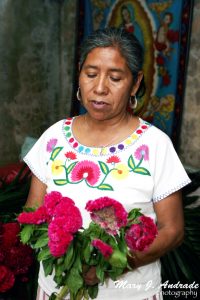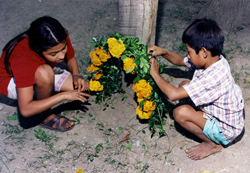
From the book “Day of the Dead, A Passion for Life.”
The prepared food for the celebration of the newly deceased in the Purhepecha Plateau in the State of Michoacan, is offered first to the deceased, so that they may take advantage of the vital flow of the food on the altar; the physical part is left for relatives and friends.
The Purhepecha, like the Maya, are a culture of corn, therefore not only the nutritional value of this product of the earth is rooted here, but the cultural value as well.
Animecha Ke’jtsitakua – Offering of the Dead
Among the traditional foods that are prepared for the celebration, the corunda (tamal) called huaparikata stands out, made from a base of new corn, that begins to be harvested in October, giving it a five point star shape, like a geometric figure.
This corunda that also represents the star or the atomo divino (soul) of the dead, like the parakatatsitsiki flower, relates to the swarm of butterflies that for many represents the return of the souls.

The pan de muerto (bread of the dead), with its own designs depicting the beliefs of that region, is made in the shape of a rabbit – aguani – that represents man, since in San Lorenzo the belief is that the soul, is the daughter of the moon. The bread with the human figure – guapita – in the form of a doll represents the woman.
From the day before the first of November in San Lorenzo, the women, relatives and friends rise early to prepare the chile for the nacatamales. At midnight, the church bells ring, announcing the arrival of the souls.The hosts boil the corn in wood ash to make the nixtamal, and very early the next day they make great quantities of batter for the nacatamales, along with the red mole of the guajillo chile. The atapakua is seasoned with mushroom, green vegetables, beef, and many times it is made from a vegetable base, according to each family’s preference.
Community Activities: The Ke’jtsitakua – Food Offerings
The Jimbanqua ritual or celebration of the newly deceased has, as one of the predominant elements at the family level, the placing of altars and offerings. The altar is a sacred place where the living show their love for the dead, co-existing with them in memory. Flowers, the decedent’s belongings, and offerings are placed on the altar, and members of the community participate in this activity.

Hot wooden coals burn the incense smoke at the base of the altar in black clay ashtrays, aromatise the environment, cleansing it of impurities.
According to Bertha Alicia Cruz, cultural promoter of San Lorenzo, the hosts receive the offerings, and place them on the main mat of the troje where they would place everything that friends and neighbors bring. At the same time, the women come out with two or three kilos of batter that had been prepared earlier for the nacatamales, as well as a handful of corn leaves, and apatakua made of red mole, beef and chopped onion. As retribution for the offerings of fruit, they give these condiments to the visitor so that she can make her nacatamales.
This custom continues on the first of November, since a continuous procession of women that go to celebrate that year’s dead can be seen in the homes where there is a celebration.
It was part of the celebration in this town that children would go to the houses with bunches of flowers to contribute to the families. From the early morning hours, the groups of children would get together to comb the countryside and hills, picking flowers for the arches that are made to adorn the houses the night of the first of November.
The children continue participating in that custom, although it is not as attractive as before, according to Bertha Alicia.
The Floral Arch

On the afternoon of the first of November, the men that go to the celebration house are in charge of designing the floral arch; this is specific to that population since the semicircle signifies that death is an expression of birth toward another dimension. This semicircle has wings, because the Purhepecha believe that the deceased becomes a winged being that flies with his guardian angel toward the dimension of the disembodied.
The arch is adorned with the traditional flowers. Seasonal fruits are hung from the arch, as well as the huaparikata, wrapped in corn leaves; uchepo, which is a sweet food prepared with ground corn mixed with piloncillo sugar and cinnamon, also wrapped in corn leaves; corn gorditas seasoned with sugar; and the nacatamales.
Candles are placed on the sides of the arches’ wings, while a cross rises above the arch. Between seven and ten at night the families keep the vigil in the cemetery, with the arch placed over the tomb. They also take all types of fruit and food, covered with embroidered napkins, as well as incense and candles. A luminous panorama can be seen at the burial place, filled with flowers, colored with the fringed napkins and the clothing worn by the women dressed in their shawls.
The family of the one being celebrated is gathered at the foot of the tomb as well as other people, to remember their ancestors. The ones who pray count their rosary beads, led by the mayor who is in charge of a group of elders, who have functioned before as mayors of the community for one year. Whoever has functioned as a civil authority becomes a religious authority, with responsibility in the different celebrations of San Lorenzo.
Charapan and the Tradition of the Day of the Dead

Similar to San Lorenzo, in Charapan an important Purhepecha town before the Spaniards arrival, the altar is placed on the eve of the celebration of the newly deceased. The family and friends take charge of constructing the wooden cross, etching the name of the deceased on it. Only the ocote wood is used, which is the heart of the old pine tree called yarin in Purhepecha. It is a type of wood that oozes a large amount of resin, which makes it last a long time.
It must be noted, as characteristic of Charapan, that this work is done while keeping vigil next to the altar. The next day, whether the first or second of November, the cross is taken to the burial place.
According to the custom, during the celebration of the Day of the Dead, at the burial place, all of the crosses are gathered together around the provisional chapel, so that the priest can bless them after the mass is celebrated at noon.
In Charapan, arches are made to take to the tombs. In many of these communities, the customs are similar, though there are details that identify each from the others.
To order any of the publications on Day of the Dead by author Mary J. Andrade please return to the Home page and click on “Day of the Dead Books” banner.


